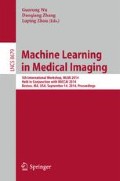Abstract
Support vector machine significance maps (SVM p-maps) previously showed clusters of significantly different voxels in dementia-related brain regions. We propose a novel feature selection method for classification of dementia based on these p-maps. In our approach, the SVM p-maps are calculated on the training set with a time-efficient analytic approximation. The features that are most significant on the p-map are selected for classification with an SVM classifier. We validated our method using MRI data from the Alzheimer’s Disease Neuroimaging Initiative (ADNI), classifying Alzheimer’s disease (AD) patients, mild cognitive impairment (MCI) patients who converted to AD within 18 months, MCI patients who did not convert to AD, and cognitively normal controls (CN). The voxel-wise features were based on gray matter morphometry. We compared p-map feature selection to classification without feature selection and feature selection based on t-tests and expert knowledge. Our method obtained in all experiments similar or better performance and robustness than classification without feature selection with a substantially reduced number of features. In conclusion, we proposed a novel and efficient feature selection method with promising results.
Access this chapter
Tax calculation will be finalised at checkout
Purchases are for personal use only
Preview
Unable to display preview. Download preview PDF.
References
Cuingnet, R., Gerardin, E., Tessieras, J., et al.: Automatic classification of patients with Alzheimer’s disease from structural MRI: A comparison of ten methods using the ADNI database. Neuroimage 56(2), 766–781 (2011)
Chu, C., Hsu, A., Chou, K., et al.: Does feature selection improve classification accuracy? Impact of sample size and feature selection on classification using anatomical magnetic resonance images. Neuroimage 60, 59–70 (2012)
Bron, E., Steketee, R., et al.: Diagnostic classification of arterial spin labeling and structural MRI in presenile early stage dementia. Hum. Brain Mapp. 35(9) (2014)
Gaonkar, B., Davatzikos, C.: Analytic estimation of statistical significance maps for support vector machine based multi-variate image analysis and classification. Neuroimage 78, 270–283 (2013)
Mourão Miranda, J., Bokde, A.L.W., Born, C., et al.: Classifying brain states and determining the discriminating activation patterns: Support Vector Machine on functional MRI data. Neuroimage 28(4), 980–995 (2005)
Wang, Z., Childress, A.R., Wang, J., Detre, J.A.: Support vector machine learning-based fMRI data group analysis. Neuroimage 36(4), 1139–1151 (2007)
Jack, C., Bernstein, M., Fox, N., et al.: The Alzheimer’s Disease Neuroimaging Initiative (ADNI): MRI methods. J. Magn. Reson. Imaging 27(4), 685–691 (2008)
Seghers, D., D’Agostino, E., Maes, F., Vandermeulen, D., Suetens, P.: Construction of a brain template from MR images using state-of-the-art registration and segmentation techniques. In: Barillot, C., Haynor, D.R., Hellier, P. (eds.) MICCAI 2004. LNCS, vol. 3216, pp. 696–703. Springer, Heidelberg (2004)
Chang, C.C., Lin, C.J.: LIBSVM: A library for support vector machines. ACM TIST 2(3), 27 (2011)
Gousias, I., Rueckert, D., Heckemann, R., et al.: Automatic segmentation of brain MRIs of 2-year-olds into 83 regions of interest. Neuroimage 40, 672–684 (2008)
Bastos Leite, A., Scheltens, P., Barkhof, F.: Pathological aging of the brain: an overview. Top Magn. Reson. Imaging 15(6), 369–389 (2004)
Frisoni, G., et al.: Detection of grey matter loss in mild Alzheimer’s disease with voxel based morphometry. J. Neurol. Neurosurg. Psychiatry 73, 657–664 (2002)
Chételat, G., et al.: Mapping gray matter loss with voxel-based morphometry in mild cognitive impairment. Neuroreport 13, 1939–1943 (2002)
Pennanen, C., Testa, C., Laakso, M.P., et al.: A voxel based morphometry study on mild cognitive impairment. J. Neurol. Neurosurg Psychiatry 76(1), 11–14 (2005)
Author information
Authors and Affiliations
Editor information
Editors and Affiliations
Rights and permissions
Copyright information
© 2014 Springer International Publishing Switzerland
About this paper
Cite this paper
Bron, E., Smits, M., van Swieten, J., Niessen, W., Klein, S. (2014). Feature Selection Based on SVM Significance Maps for Classification of Dementia. In: Wu, G., Zhang, D., Zhou, L. (eds) Machine Learning in Medical Imaging. MLMI 2014. Lecture Notes in Computer Science, vol 8679. Springer, Cham. https://doi.org/10.1007/978-3-319-10581-9_34
Download citation
DOI: https://doi.org/10.1007/978-3-319-10581-9_34
Publisher Name: Springer, Cham
Print ISBN: 978-3-319-10580-2
Online ISBN: 978-3-319-10581-9
eBook Packages: Computer ScienceComputer Science (R0)

